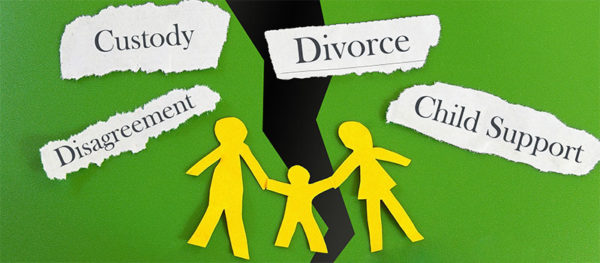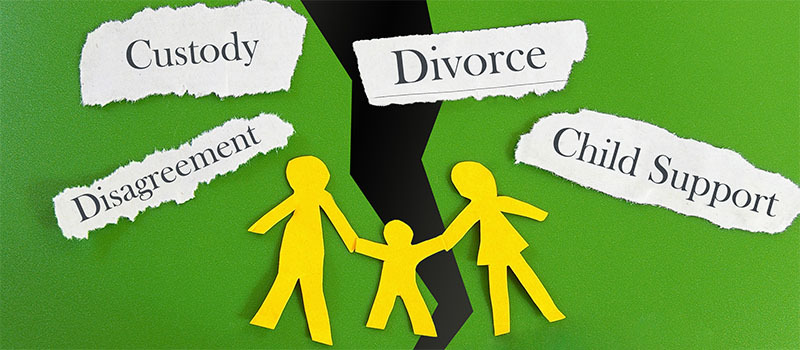Divorce is a difficult process in more ways than one. For instance, you’ll probably need to learn the significance of the terms such as qualified domestic relations order, QDRO, and QDRO process before it’s all said and done. And that’s only part of the new things you’ll pick up quickly if you want to protect yourself financially during and after a divorce.
We’re not going to sugarcoat things and say that learning about those things beforehand will make the whole ordeal easier. The reality is that the divorce will likely still be hard on you. What’s important, though, is that you’re doing all you can to preserve your finances while also giving yourself a sturdier leg to stand on moving forward.
Learn more about how dividing retirement accounts work during a divorce and prepare yourself properly for what lies ahead.

What Is Considered Shared Property and What Is Not?
Before we get to the machinations of dividing retirement accounts, we first need to determine which funds are subject to the divorce proceedings. Labeling those assets properly matters during the process of division.
Let’s start by identifying the assets that don’t count as shared property.
The courts do not consider funds that you receive as an inheritance or as a gift from someone as shared property. They do not need to be factored into the equation when the time comes to divide everything equally.
The assets that were under your name before you got married will also remain as your sole property.
Where things get a bit trickier is when you’re trying to portion out the funds in retirement accounts. Some of the funds found in there could be subject to division, while others may not.
If there were funds already present in your retirement accounts prior to getting married, they would regard those as separate properties. They will not be included in the calculations when the assets are divided.
The assets considered are the ones added to your retirement accounts throughout the marriage. They will also fairly divide other assets that were accumulated by both parties during the marriage.
How Retirement Accounts Are Divided
The process of divvying up the funds inside retirement accounts during a divorce will depend largely on what kind of account it is. To be more specific, it will depend on whether you want an individual retirement account (IRA) or a qualified plan divided.
Let’s start by discussing IRAs first because they are relatively simpler to divide and transfer.
Dividing IRAs
When it comes to dividing IRAs, both parties in the divorce will first need to specify which of their accounts count as such. The court will then take over from there.
The court’s role is to divide the assets included in the IRAs. They will determine how much you receive and how much your ex-partner will receive. Once again, the assets accumulated during the marriage are the ones they will count.
Dividing the funds included in IRAs is simple enough. Transferring them to different accounts is a bit more complicated.
Transferring the Funds from IRAs
You have two choices here when it comes to how they will transfer the funds from the IRAs.
First off, you could opt to spend the money you’re getting from those IRAs right away. In that case, prepare to pay some taxes.
As the recipient, you will pay income taxes on that new money that came in. You will likely pay a premature penalty since you are opting to withdraw the funds early.
It’s worth pointing out here that you may also end up paying those taxes and penalties if you’re not careful. Failing to indicate that you want those funds transferred to a separate IRA will result in the money being given to you right away. Because of that, you’ll still pay the taxes and penalties.
To avoid those taxes and penalties, you should indicate that you want a transfer incident. Upon deciding that you want the funds moved via a transfer incident, they will go from your ex-partner’s IRA to your new account. They will not ask you to pay for anything at this point if you decide to go with a transfer incident.
However, you will oversee how to use the funds once they transfer them to your new account. You can still take the money out ahead of schedule if the need arises but know that you’ll need to pay a possible penalty then. Your ex-partner will no longer have any say over how you use that money, and they will also have no other tax obligations.
Dividing Qualified Retirement Plans
Dividing an IRA is one thing. Both sides know how much money their IRAs contain, it’s easy to divide them between the two parties.
But what happens if the money isn’t available right away? In some cases, retirement assets are tied up in their retirement plans.
To resolve that matter, you can secure something known as qualified domestic relations order.
What Is a Qualified Domestic Relations Order?
The qualified domestic relations order, also known as a QDRO, is an order handed down by the court that indicates how they will disburse certain funds. More specifically, it lays out instructions for how the funds you’re entitled to that are currently in your ex-spouse’s retirement plan will be handled.
The QRDO can be used to dictate how your ex-spouse’s retirement plan will pay for their share of child support, alimony, or even cover for property rights that they could not divide equally. You can also have the funds funneled into a new retirement account you’ve set up.
Similar to transfer incidents, funds moved through QRDOs are tax and penalty-free. Note that funds coming from your ex-partner’s retirement plan that is not being transferred by a QRDO will still be subject to taxes and penalties.
As the recipient of the funds from your former spouse’s retirement plan, you have additional responsibilities to take on as well. The good news is that the most you’ll need to do is make regular reports about the payments you’re receiving. It’s an added chore, but one you should handle easily.
The Limitations of Qualified Domestic Relations Orders
You cannot automatically assume that the retirement plan your ex-partner has can be subjected to a qualified domestic relations order. Those orders don’t cover everything.
QDROs are limited only to qualified retirement plans as designated by ERISA or the Employee Retirement Income Security Act. Those retirement plans include defined benefit plans and defined contribution plans.
Dividing Defined Benefit Plans
Defined benefit plans are sponsored and managed by the employers. The employers themselves will usually share the formula they’re using so that their employees have a good understanding of how much they can expect to receive in the future.
According to Investopedia, you can use factors such as an employee’s salary and employment history to come up with the figure for the defined benefit plan. You should also know that you cannot withdraw the funds from a defined benefit plan easily. Those plans usually designate a specific age when they pay out, so calculating their final value can be put off until then.
Dividing the funds from defined benefit plans is hard to do because of how they are structured.
There is no set value to provide. Because of that, they will need to calculate to determine how much you are entitled to. Those calculations will be quite complex since they should only account for the benefits accumulated while the marriage was in effect.
The amount of money you receive from a defined benefit plan can also be determined by how you want it paid out.
You can opt to have the payment deferred and wait until the plan reaches maturity before claiming your share. As the ex-partner, you can have the option of claiming your share now, depending on the value of the defined benefit plan.
Regardless of how you want the benefits paid out, the court will still be the one to decide how to divide the funds between you and your former spouse.
Dividing Defined Contribution Plans
Compared to defined benefit plans, it’s easier to portion out defined contribution plans between two parties. The main reason is that the amount is clearly defined.
Employees contribute a fixed percentage or amount of their salary to their defined contribution plan. So, it’s easy to calculate how much one party has contributed to their plan over the length of a marriage, and that amount can be divided.
Investopedia does note that there are cases where the employers match their employees’ contributions to boost their benefits. You may get those additional contributions as the former spouse.
The court will again be the one in charge of determining how they divide the money from a defined contribution plan.
How to Secure a Qualified Domestic Relations Order
Given that there are other parties involved in the handling of retirement plans, securing a QDRO is not as straightforward as getting an order from a court. The plan administrator will be involved, and you will require the help of an attorney at this point.
You want to start working with an experienced attorney at this point because of how intricate retirement plans can be. Attorneys who haven’t spent that much time studying retirement plans may miss something important that, in turn, could cost you a good chunk of money once you finalize the divorce.
Leave the drafting of the QDRO to an attorney who has already dealt with retirement plans extensively in the past to ensure that you are getting your fair share. Opting to have an attorney take care of that will also free you up to focus on other matters that are related to your divorce proceedings.

Additional Tips for Securing Your Fair Share of Funds from Retirement Accounts
Working with a knowledgeable attorney is how you can avoid getting the short end of the stick during asset division. Author, businessman, and financial expert Dave Ramsey has additional tips you can follow to protect your fair share of the money.
Secure the Separation of Finances Immediately
Once you and your spouse have decided that your marriage is over, you should move right away to secure your finances. This means closing any joint accounts the two of you have and securing your portion of retirement plans as soon as possible. Acting this way will prevent your ex-spouse from potentially driving down the amount of money you are supposed to receive.
In addition to those actions, you may want to freeze your credit as you’re going through the divorce proceedings. That should prevent your ex-partner from pulling any funny business, such as taking out loans under your name.
Get Everything Down in Writing
You and your ex-partner reaching an agreement regarding how you’ll divide your assets would be ideal. That’s not something you typically want to leave up to the courts.
However, you shouldn’t buy into everything your ex-partner is saying, either. If the two of you do have an agreement, insist on getting it down in writing and make sure that it’s legally binding. That will ensure it holds up in court, and you don’t end up getting blindsided.
Educate Yourself about Retirement Accounts
Remember that those QDROs are helping you receive money from retirement plans. Now would be a good time to learn more about those retirement plans if you haven’t started reading up already.
While you’re at it, you can also use this time to find out how to best use that money. You may have a tough time adjusting to living on a single income again and saving up for your future following the divorce. Find out how you can best use that money to keep yourself financially stable.
The division of retirement accounts following a divorce can turn into a complicated undertaking. Enlist the help of experienced attorneys to make it more manageable. Reach out to us at the Schill Law Group and allow us to help get those financial matters sorted.














